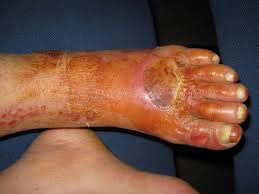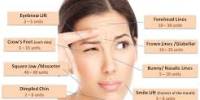Background
It is estimated that approximately 15% of the more than 150 million people with diabetes world-wide will at some stage develop diabetic foot ulceration. Diabetes mellitus is a chronic disease caused either by a deficiency in the production of insulin by the pancreas, or by the inability of the body to utilize the insulin produced. The condition needs constant monitoring to be kept in check and is linked to a number of serious complications such as vascular disease, retinopathy, diabetic nephropathy and diabetic foot ulcers. (Conva Tec USA, n.d,)
Diabetic foot is often quite a dreaded disability, with long stretches of hospitalization, and impossible, mounting expenses, with the ever dangling end result of an amputated limb. The phantom limb plays its own cruel joke on the already demoralized psyche. The diabetic foot, no wonder, is one of the most feared complications of diabetes. Diabetic foot is characterized by a classical triad of neuropathy, ischemia, and infection. Preventing the diabetic foot should be the first priority. This can be achieved by identifying the high-risk individuals, like those with peripheral neuropathy, peripheral vascular disease, foot deformities, and presence of callus. ( Pendsey, 2010, p.75-79).
The prevalence of foot ulceration among patients with diabetes mellitus ranges from 1.3% to 4.8% in the community, to as high as 12% in hospital. This represents considerable patient morbidity, and is associated with substantial health-care costs. The pathophysiology of diabetic foot ulceration is multifactorial, but peripheral neuropathy is thought to be responsible for most cases. To prevent foot ulceration and amputation, clinical guidelines recommend early identification of risk, based on annual foot screening of all diabetic patients, with targeting of preventive and treatment interventions to ‘high risk’ individuals. Key to this preventive strategy is a structured clinical assessment that incorporates diagnostic tests alongside a thorough history and examination. (Predicting foot ulcers in patients with diabetes: a systematic review and meta-analysis,2007, p. 65-86).
Diabetic patients who have poor glycemic control may suffer from foot ulceration. This complication has become more prevalent since advances in the general medical care of diabetes particularly the discovery of insulin has prolonged the life expectancy of patients with this disease. A study revealed that 3% of total hospital admissions were of diabetic foot. (Haroun, Shukr, Choudhry, & Hussain, 2009,)
Treatment of diabetic foot ulceration is much more complex than simply putting a dressing over a wound. Diabetic foot ulceration is a significant cause of morbidity and is the most common reason for hospital admission in diabetic patients. Annually, two to three percent of diabetic patients1,2 will develop foot ulcers, and up to 15 percent of diabetic patients will develop chronic ulcers during their lifetimes. In those who require lower-limb amputation, 70 to 90 percent will be preceded by a foot ulceration. (Dinh, Pham, Veves, n.d.)
There is currently little consistency in the education provided to people with diabetes regarding foot health and foot self-care. Of particular concern are those patients who are considered to be at low risk of developing diabetes-related foot complications. These patients may receive little, if any, information about these complications and how they might be avoided .There is little specific evidence-based guidance regarding the content or provision of foot care advice for diabetes patients without established (overt symptoms of) neuropathy or peripheral vascular disease . Indeed, only two specific guidelines currently exist for this patient population—those published by the American Diabetes Association and the International Working Group on the Diabetic Foot in 2004 and 2007, respectively. (McInnes, et al.2011, p. 162-167)
Diabetes mellitus (DM) is a metabolic disorder that is characterized by chronic hyperglycaemia; it is a common and potentially disabling chronic disease. The condition is presently afflicting 194 million people worldwide and is estimated to rapidly increase to 333 million people in 2025 as a consequence of longer life expectancy, sedentary lifestyle and changing dietary patterns. This rise in prevalence of DM is likely to bring a concomitant increase in its complications among diabetic patients. One important complication of DM are the foot problems; these complications constitute an increasing public health problem and are a leading cause of admission, amputation and mortality in diabetic patient. In addition to causing pain and morbidity, foot lesions in diabetic patients also have substantial economic consequences, beside the direct costs of foot complications, there are also indirect costs relating to loss of productivity, individual patients’ and family costs and loss of health related quality of life. The lifetime risk of a person with diabetes developing a foot ulcer could be as high as 25%, and it is believed that every 30 seconds a lower limb is lost somewhere in the world as a consequence of diabetes.( Desalu, Salawu, Jimoh, Adekoya, Busari, Olokoba,2011p. 60-65)
Diabetes is reaching epidemic proportions and with it carries the increased risk of complications. Disease of the foot is among one of the most feared complications of diabetes. The term ‘Diabetic Foot’ consists of a mix of pathologies including diabetic neuropathy, peripheral vascular disease, Charcot’s neuroarthropathy, foot ulceration, osteomyelitis and the potentially preventable endpoint, limb amputation. The lifetime risk of a person with diabetes developing foot ulceration is reported to be as high as 25%. (The diabetic foot,2008, p. 685-695)
DF is the main cause of nontraumatic lower extremity amputations and precedes 85% of the cases. DF lesions are a significant health and socioeconomic problems, having adverse effects on the quality of life and imposing a heavy economic burden on the patient and the State; it can lead to prolonged hospitalization and the need for rehabilitative and home care services. The development of a foot ulcer is traditionally considered to result from a combination of peripheral vascular disease, peripheral neuropathy and infection. More recently, some factors have been identified that are believed to increase the risk of amputation in these patients. Early recognition and management of risk factors for foot complications may prevent amputations, especially of the major type and prevent other adverse outcomes. (Shojaiefard , Larija, 2008, p. 32-37)
JUSTIFICATION OF STUDY
This study will be help to findout: The overall prevalence of diabetic foot among diabetic patients. The risk factors associated with diabetic foot such as socio-economic factors, medical factors and psychological factors. Minimize the risk factor of diabetic foot with its complication in diabetic patients. The economic burden associated with diabetic foot is preventable in many cases. To knowledge buildup including patient education, foot care, and the use of appropriate footwear ,may be cost effective or even cost saving if applied to patients with risk factors for foot ulcers. Treatment seeking behaviors with diabetic patients. Find out the level of dependency with diabetic foot and build up the rehabilitation program to minimized dependency as well as improved functional activity. Seventy-one percent of the amputations were precipitated by a foot ulcer. The purpose of this study to evaluate the change in diabetes-related lower extremity amputations as well as the recurrence of foot ulcers. Diabetic foot problem are indeed a global problem and there is no area in the world that does not report the development of foot lesions as a consequence mainly of neuropathy and vascular disease with in the diabetic patients. This study will also help to find out the severity and prognosis of diabetic foot among diabetic patients. The database will also help in term of health care priority planning and financial allocation; assess the effectiveness of diabetic treatment, enable us to compare our treatment outcome with the rest of the world, and also as a tool in diabetes awareness and health education programmed. Clearly we have a long way to go in reaching our targets with our diabetic foot care in Bangladesh. Not at least, we also need convincing data to demonstrate the lack of awareness and proper care in particular and its burden within in this country. This study will also help to support our policy and clinical decision-making in improving access to treatment and in improving the provision and delivery of diabetic foot services in Bangladesh.
OPERATIONAL DEFINITIONS
Nerve damage (neuropathy)
Elevated blood glucose levels over time can damage the nerves of the foot, decreasing a person’s ability to notice pain and pressure. Without these sensations, it is easy to develop callused pressure spots and accidentally injure the skin, soft tissue, bones, and joints. Over time, bone and joint damage can dramatically alter the shape of the foot. Nerve damage, also called neuropathy, can also weaken certain foot muscles, further contributing to foot deformities. (McCulloch ,n.d).
Vascular disease
Peripheral arterial disease (PAD) is a contributing factor to the development of foot ulcers in up to 50% of cases. It commonly affects the tibial and peroneal arteries of the calf. Endothelial cell dysfunction and smooth cell abnormalities develop in peripheral arteries as a consequence of the persistent hyperglycemic state.There is a resultant decrease in endothelium-derived vasodilators leading to constriction. There is also the potential for alterations in the vascular extracellular matrix leading to stenosis of the arterial lumen. Cumulatively, this leads to occlusive arterial disease that results in ischemia in the lower extremity and an increased risk of ulceration in diabetic patients. (Clayton Jr, Elasy,2009 ,p. 52-58)
Poor circulation
Longstanding high blood sugar can damage blood vessels, decreasing blood flow to the foot. This poor circulation can weaken the skin, contribute to the formation of ulcers, and impair wound healing. Some bacteria and fungi thrive on high levels of sugar in the bloodstream, and bacterial and fungal infections can break down the skin and complicate ulcers. (McCulloch, n.d)
Poorly fitting or inappropriate foot wear
Inappropriate shoes increase the risk of callous and ulcer formation, as well as increasing the risk of falls.( Burns, Leese, McMurdo,2002, p. 344-346)
Foot deformity
Deformity of the feet is a risk factor because shoes are not designed to fit deformed feet. A prominent bone could thus rub in shoes and cause a sore or wound. If there is loss of feeling as well as deformity the risk is even greater because the person may not feel the shoe rubbing. Deformity may be as obvious as a prominent bone or a crooked toe; however, it could also be subtle like a thick toenail or a callus. Regardless, if possible deformities should either be addressed with properly fitted shoes or even fixed with an operation. (The diabetic foot – Introduction,n.d)
You +1’d this publicly. Undo
Callus
Callus on the sole of the foot has been found to be highly predictive of subsequent ulcer formation among people with diabetes. It is generally accepted that such a callus is secondary to altered loading of the metatarsal heads seen in people with diabetic peripheral neuropathy, and possibly also as a consequence of soft tissue glycation. Such calluses could be plantar warts caused by human papillomavirus. Here, the authors report a case of diabetic foot ulceration in association with verruca.(Griffiths, Fish, Andrews,2012, p. 84-86)
Increased duration of diabetes
The longer the patient has had diabetes, the more likely they have developed one or more major risk factors for diabetic lower extremity problems.( Ferry Jr,n.d).
Poor knowledge of diabetes
Good foot care begins with a solid understanding of the processes that can cause foot injury. For diabetics, uncontrolled glucose in the blood stream can eventually begin to damage the blood vessels that nourish the nerves in the legs and feet. Over time, the nerves themselves can become damaged, leading to sensations of burning, tingling, numbness or pain that typically start in the toes. If corrective action is not taken, all feeling in the feet can be lost. Without proper sensory information, it is possible to injure your feet without being aware of the fact. Add to this situation diminished circulation and lack of proper blood
flow, and you have a perfect recipe for serious infection and permanent disability. In the most advanced cases, the process ends in the development of gangrene and the need for amputation.(Gideon Hoyle,n.d)
Psychological factors
Psychological factors influencing adherence behaviours, emotional status and quality of life in diabetic patients at high risk of developing foot ulcers.( Vileikyte,Rubin, & Leventhal,2004).
Smoking
If you smoke any form of tobacco, quitting can be one of the best things you can do to prevent problems with your feet. Smoking accelerates damage to blood vessels, especially small blood vessels leading to poor circulation, which is a major risk factor for foot infections and ultimately amputations. (Ferry Jr, n.d)
Sedentary Lifestyle
A lack of daily physical activity can lead to obesity, a major factor in developing type 2 diabetes. Persons with type 2 diabetes are at increased risk for heart disease, stroke, kidney disease, eye complications, and foot and skin problems. (Hicks,2008)
Obesity
An obese person is anyone carrying over 20% beyond healthy weight for age and height. For diabetics, this can cause diabetic nerve damage, meaning a sprain or minor stress fracture simply does not hurt. Not so well known may be the increase in severe diabetic foot problems, sometimes leading to amputation of an entire leg. (Pritchett, 2010)
RESEARCH QUESTION
1. What will be the prevalence of diabetic foot among diabetic patients?
LITURATURE REVIEW
Foot complications are common in diabetic patients and are considered one of the most expensive diabetes mellitus (DM) complications to treat. The study was part of a general cross-sectional survey carried out to assess the prevalence and risk factors for foot complications among diabetic patients in Al-Ain district, United Arab Emirates (UAE). A sample of 513 diabetic patients with a mean age of 53 years (SD: ± 13) were randomly selected during 2003/2004. All completed an interviewer-administered questionnaire and underwent medical assessment including foot examination and assessment of presence of peripheral neuropathy (PN) and peripheral vascular disease (PVD).Forty nine percent of the study populations were diagnosed to have DM without presenting with symptoms of diabetes and 35% had hypertension. The majority (86%) had type 2 DM. Of the total sample, 39% (95% CI: 35.1-43.7%) had PN and 12% (95% CI: 8.8–14.4%) had PVD. There were no cases of amputation and only one case had previous history of lower extremity ulceration. Significant risk factors for PN and PVD were: male gender, poor level of education, UAE nationality, increased duration of diabetes, type 2 DM, presence of hypertension and microalbuminuria (MA). (Al-Maskari, El-Sadig, 2007)
The study subjects were selected from the foot clinic of the M.ViswanathanHospital for diabetes, which is a large referral center for diabetes in southern India. Patients of different socioeconomic status visit the hospital. In this project 2,642 patients (1,751 men and 891 women) with a high-risk foot were selected according to criteria of the International Consensus on the Diabetic Foot. The study subjects were divided as urban, patients staying in cities and bigger towns (n = 1,377), and rural, patients staying in the villages away from main town or city (n = 1,265). Intergroup differences were absent in the duration of diabetes and the prevalence of peripheral vascular disease. The mean age of the urban sample was higher than that of the rural sample (P = 0.01). Prevalence of foot infection was higher among rural than urban patients (26 vs. 34%, P = 0.0001). Amputation rates were also higher among rural than urban patients (3 vs. 8%, P < 0.05). Recurrence of foot infection was higher among rural than urban patients (8 vs. 13%, P = 0.003). Surgical intervention was also more frequent among rural than urban patients (6 vs.10%, P = 0.04). (Viswanathan, Madhavan, Rajasekar, Snehalatha& Ambady, 2006 p. 701-703)
A cross sectional study was conducted during the period from June 2009 till January 2010 in a primary care clinic at King Khalid University hospital, Riyadh, Saudi Arabia.The study showed that the prevalence of diabetic foot among 224 diabetic patients attending a primary care clinic, was 6.2%, and 1.3% of diabetic patients had amputated foot. About half of the diabetic patients were 60 years and above. Most of the patients (69.7%) were on oral hypoglycemic agents, and 28.1% were on insulin. Only 31.7% had HBA1C less than 7, 33% followed their blood sugar levels regularly at home by gluco meter, and only 30.8% of diabetic patients examined their feet regularly at home. (Al Turki,2010 p. 18-23)
In this U.K. population-based study, we screened 15,692 type 1 and type 2 diabetic patients in the community health care setting for foot ulcers, foot deformities, neuropathy, and PAD plus other characteristics. In total, 13,409 were European (85.5%), 1,866 were South Asian (11.9%), and 371 were African Caribbean (2.4%). The age-adjusted prevalence of diabetic foot ulcers (past or present) for Europeans, South Asians, and African Caribbeans was 5.5, 1.8, and 2.7%, respectively (P < 0.0001). Asians and African Caribbeans had less neuropathy, PAD, and foot deformities than Europeans (P = 0.003). The unadjusted risk of ulcer (odds ratio [OR]) for Asians versus Europeans was 0.29 (95% CI 0.20-0.41) (P < 0.0001). PAD, neuropathy, foot deformities, and insulin use attenuated the age-adjusted OR from 0.32 to 0.52 (0.35-0.76) (P < 0.0001). African-Caribbean versus European ulcer risk in males was attenuated from 0.60 to 0.71 by vibration sensation. (Vileikyte., Rubin., Leventhal.,2004)
The effect of ethnicity on diabetic foot ulceration (DFU), neuopathy and peripheral arterial disease (PAD) remains controversial, with few previous studies from Egypt. The prevalence of DFU and its risk factors in a cohort of patients presented to the outpatient diabetes clinic at MansouraUniversitySpecializedMedicalHospital. Over a period of 12 months, 1220 diabetic patients were screened for DFU, neuropathy, PAD, foot deformities, and skin and nail abnormalities. The mean age was 50.5 ± 10.9 years and 36.8% were male. Diabetes duration was 7.9 ± 5.9 years and BMI 34.5 ± 6.7. The prevalence of active or past foot ulceration was 1.2% and 5.7% respectively. Monofilament insensitivity was found in 124 patients (10.2%). Only 38 patients (3.1%) had absent foot pulses. We found dry skin in 544 patients (44.6%), calluses in 69 (5.7%), tinea pedis in 532 (43.6%) and thick nails in 215 (17.6%); 61.6% of our patients used inappropriate footwear and 93.8% received no prior foot education. (El-Nahas, Gawish,Tarshoby, State&Boulton,2008 p. 362–366)
To survey diabetic foot problems in the Taiwanese population, a total of 16,994 non type 1 diabetic patients were randomly selected for telephone interview from a group covered by the National Health Insurance (>96% of the total population is covered by this health care system). They were questioned on whether they had diabetic foot problems, as indicated by ulcer, gangrene, or amputation on the lower extremities. Lifetime prevalence was calculated, and various risk factors were analyzed. A total of 12,531 case subjects (response rate 73.7%) were successfully interviewed. Diabetic foot problems were present in 369 patients (prevalence 2.9%) with 540 initiating events. Ulcers represented 86.7% of all initiating events. Approximately 26.9% of the ulcers progressed to gangrene or amputation, and ulcers preceded 71.9% of all amputations.(Tseng, 2003, p. 335 )
A cross-sectional study was conducted for male diabetics in the Aseer region, KSA, during the first quarter of the year 2004.A questionnaire and physical examination of the foot were used to assess their behaviors towards foot care. All the male diabetic patients (107) who attended during the study period were assessed. Mean age was 58 years, mean duration of DM was 10 years. Good diabetic control was 24%, 37% did not know the negative effect of DM on the feet,9-22% had different symptoms of diabetic foot ,53% checked their feet regularly ,31% had fungal infection while an absence of pulse was detected in 7%.( Al-Khaldi, 2008, p. 103-106)
METRIALS AND METHODS
III.1 Conceptual frame work
| ||||
| ||||
OBJECTIVE OF THE STUDY
|
OBJECTIVE OF THE STUDY
General objective
- To determine the prevalence of, and risk factors associated with, diabetic foot among diabetic patients.
Specific Objectives
- To determine the prevalence of diabetic foot in diabetic patient;
- To find out the factor associated with diabetic foot;
- To determine the sociodemographic factor, associated with diabetic foot;
- To assess physical inactivity with diabetic patient.
- To determine the association between sociodemographic factors and diabetic foot;
- To find out the association between risk factors and diabetic foot;
- To find out the association between behavioral factors and diabetic foot;
STUDY DESIGN
Descriptive cross sectional study will be conducted to determine the proportion and factors related to diabetic foot among diabetic patients.
STUDY POPULATION
The study population consisting of male and female patients who are affected by diabetes mellitus (age range 15-75 years) will be obtained from different government, nongovernmental and private hospitals.
STUDY AREA
This study will be conducted in different diabetic centers of Dhaka city.
STUDY PERIOD
The duration of the study will be six months. The study will be conducted from March 2012 to August 2012. The entire period will be divided into different activities.
INCLUSION & EXCLUSION CRITERIA
Inclusion criteria
- Both male and female diabetic patients aged range between15-75 years
- Duration of diabetes is 2 years & above.
Exclusion criteria
- Both male and female diabetic patients aged range between below 15 & above 75 years.
- Duration of diabetes below 2 years.
SAMPLING TECHNIQUE
Samples will be selected purposively to interview the study population considering the inclusion & exclusion criteria. This will follow the eligibility of study samples and sample size requirements different diabetic hospitals in Dhaka city will be selected purposively for collecting samples.
DATA COLLECTION INSTRUMENT/TOOL
An administered structured questionnaire will be designed to collect information on related to diabetic foot in diabetic patients through interview. The questionnaire will consisted of 3 sections of items: The first section included items on socio-demographic characteristics and background information of diabetics like sex, age, occupation; The second section included the nerve damage, vascular disease , Poor circulation, Poorly fitting or inappropriate footwear , smoking, foot deformity , length of diabetes & the third section included behavioral factors & treatment seeking behavior .
DATA COLLECTION PROCEDURE
Data collection procedure involved face to face interview and diabetes check list with the help of interviewer administered structured questionnaire.
DATA MANAGEMENT AND ANALYSIS
After collection of data, all interviewed questionnaire will check for its completeness, correctness and internal consistency to exclude missing or inconsistent data and those are be discarded. Correct data will be entered into the computer and the data will be analyzed using the statistical software namely Statistical Package for Social Science (SPSS).
ETHICAL ISSUES
Before data collection, permission from the ethical committee of State College of Health Sciences, Dhanmondi, Dhaka-1209, Bangladesh will be taken and a request letter handed over to the appropriate authority of the study area for permission and seeking assistance for smooth access to data collection. All ethical issues related to research involving human subjects are addressed according to the guidelines of the Bangladesh Medical Research Council (BMRC) and the ethical review committee of World Health Organization (WHO). Prior to data collection, the objectives of the study will be explained in understandable language to the participants and their written approval informed consent will be taken. The prospective participants will be given free opportunity to receive summary information of the study in writing before giving consent and take part in the study. Participant’s rights to refuse and withdraw from the study will be accepted. All Questionnaires and Ethical documents will be translated into Bengali if needed.
EXPECTED OUTCOME OF THE STUDY
The study expects to determine the prevalence of, and factors associated with, diabetic foot among diabetic patients.
References
Abbott, CA., Garrow, AP., Carrington, AL., Morris, J., Van Ross, ER., Boulton, AJ.(2005). Foot ulcer risk is lower in South-Asian and african-Caribbean compared with European diabetic patients in the U.K.: the North-West diabetes foot care study. Journals of Diabetes Care,28 (8),1869-75.
Al-Khaldi, Yahia M. (2008). Foot care among male diabetics in family practice center, ABHA, SAUDI ARABIA. Saudi Society Of Family and Community Medicine Journal, 15(3),103-106.
Al-Maskari, F., El-Sadig, M.(2007. Prevalence of risk factors for diabetic foot complications. Journal of BMC Family Practice, 59(8),
Al Turki, Y A.(2010). Prevalence of Diabetic foot among diabetic patients attending a primary care clinic at a teaching hospital, Riyadh, Saudi Arabia. Journal of Family and Community Medicine, 7(2),18-23.
Burns, S L., Leese, GP., McMurdo, MET. (2002). Older people and ill fitting shoes. Post Graduate Medical Journal, 78(920), 344-346
Clayton Jr,Warren., Elasy, Tom A.(2009).A Review of the Pathophysiology, Classification, and Treatment of Foot Ulcers in Diabetic Patients. Journal of American Diabetes Association, 27(2), 52-58.
Conva Tec USA.(n.d.). Retrieved February 2, 2012 ,from http:// www.convatec.com/…/an-introduction-to-diabetic-foot-ulcers/
Desalu, OO., Salawu,FK., Jimoh, AK., Adekoya, AO., Busari, OA., Olokoba,AB.(2011) Diabetic Foot Care: Self Reported Knowledge and Practice Among Patients Attending Three Tertiary Hospital in Nigeria.Ghana Medical Journal, 45(2), 60-65.
Dinh, T., Pham, H., Veves, A.(n.d.). Emerging Treatments in Diabetic Wound Care.Retrieved May 9, 2012, from http://www.woundsresearch.com/article/138.
El-Nahas,MR., Gawish,HMS.,Tarshoby,MM., State,OI.,Boulton,AJM.(2008). The prevalence of risk factors for foot ulceration in Egyptian diabetic patients. Journals of Practical Diabetes International, 25(9), 362–366.
Ferry Jr, Robert.(n.d). Diabetic Foot Care (cont.).Retrived July 20, 2012 from http:// www.emedicinehealth.com › home › diabetes center › diabetes az list.
Gideon Hoyle,M.(n.d). Foot Care for Diabetic Patients. Retrived July 20, 2012 from http:// www.ehow.com › Diseases & Conditions
Griffiths, Shelly., Fish,David., Andrews,BrainT.(2012). Human papillomavirus involvement in a diabetic foot ulcer: A case report. The Diabetic Foot Journal,15 (2),84-86.
Haroun, I., Shukr, I., Choudhry, AK., Hussain, Z.(2009). Diabetic foot lesions and their managment. Pakistan Armed Forces Medical Journal, (4).
Hicks, Jennifer. (2008). A Sedentary lifestyle and diabetes. Retrived 23, 2012 from http://www. diabetes.about.com/od/benefitsofexercise/a/sedentary7.htm
McCulloch ,David K. (n.d). Patient information: Foot care in diabetes mellitus (Beyond the Basics).Retrieved July 19, 2012, from http:// www.uptodate.com/…/patient-information-foot-care-in-diabetes-melli…
McInnes,A., Jeffcoate,W., Vileikyte,L., Game,F., Lucas,K., Higson,N., et al.(2011). Foot care education in patients with diabetes at low risk of complications: a consensus statement. Diabetic Medicin journals, 28(2), 162-167.
Pendsey , SP. (2010). Understanding diabetic foot. International Journal of Diabetes in Developing Countries, 30(2), 75-79.
Predicting foot ulcers in patients with diabetes: a systematic review and meta-analysis.(2007). QJM: An International Journal of Medicine, 100 (2), 65-86.
Pritchett, Lynn.(2010). Type 2 Diabetes, Obesity and Charcot Foot. Retrived 23,2012 from http://www. voices.yahoo.com/type-2-diabetes-obesity-charcot-foot-6477120/
Shojaiefard, A., Khorgami, Z., Larija,B.(2008). Independent risk factors for amputation in diabetic foot. International Journal of Diabetes in Developing countries, 28 (2), 32-37.
The diabetic foot – Introduction, (n.d).Retrived July 20, 2012 from http:// www.bcfootandankle.com/footintro.htm
The diabetic foot. (2008). QJM: An International Journal of Medicine, 101(9), 685-695.
Tseng, Chin-Hsiao. (2003). Prevalence and risk factors of diabetic foot problems in Taiwan. Journals of the American Diabetes Association,26 (12),335.Vileikyte, L ., Rubin, RR., Leventhal, H.(2004). Psychological aspects of diabetic neuropathic foot complications: an overview. Retrived July 20, 2012 from http:// www.ncbi.nlm.nih.gov/pubmed/15150807
Viswanathan,V., Madhavan, S., Rajasekar, S., Snehalatha, C., Ambady, R .(2006). Urban-rural differences in the prevalence of foot complications in South-Indian Diabetic Patients.Journals of the American Diabetes Association,29(3),701-703.
















